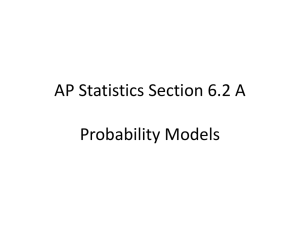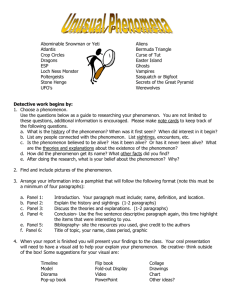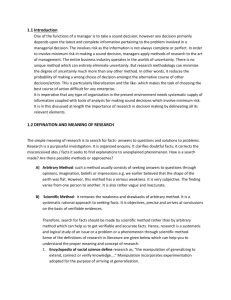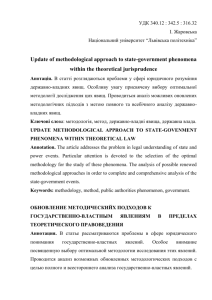European journal of natural history. - 2007. - №2. –pp. 120
advertisement
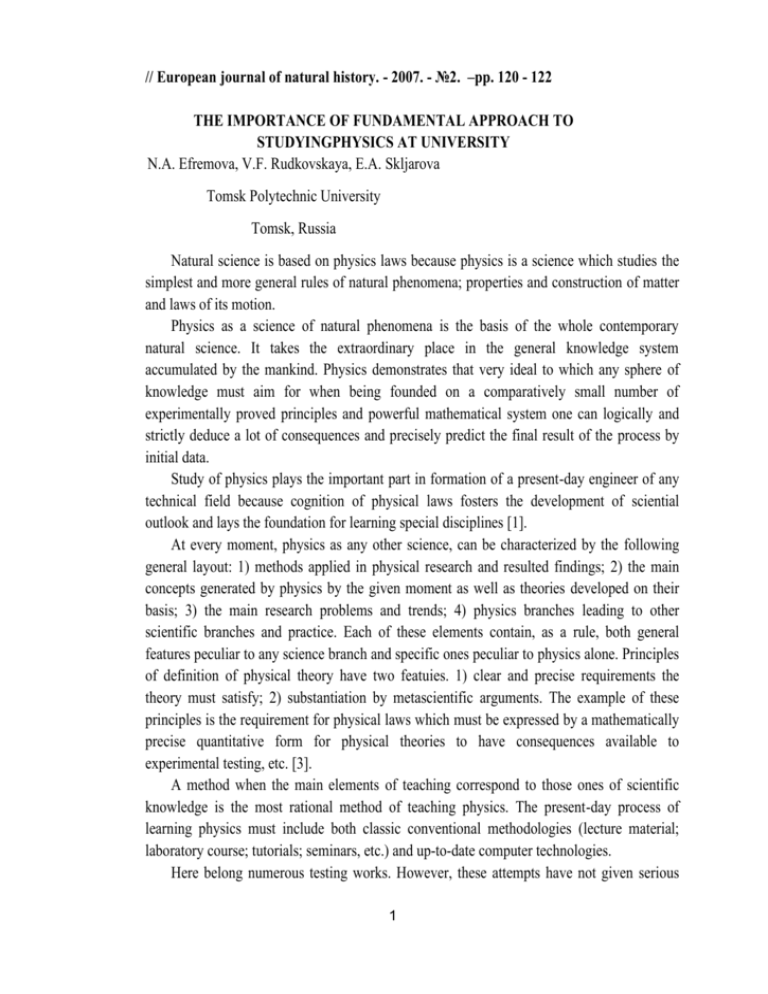
// European journal of natural history. - 2007. - №2. –pp. 120 - 122 THE IMPORTANCE OF FUNDAMENTAL APPROACH TO STUDYINGPHYSICS AT UNIVERSITY N.A. Efremova, V.F. Rudkovskaya, E.A. Skljarova Tomsk Polytechnic University Tomsk, Russia Natural science is based on physics laws because physics is a science which studies the simplest and more general rules of natural phenomena; properties and construction of matter and laws of its motion. Physics as a science of natural phenomena is the basis of the whole contemporary natural science. It takes the extraordinary place in the general knowledge system accumulated by the mankind. Physics demonstrates that very ideal to which any sphere of knowledge must aim for when being founded on a comparatively small number of experimentally proved principles and powerful mathematical system one can logically and strictly deduce a lot of consequences and precisely predict the final result of the process by initial data. Study of physics plays the important part in formation of a present-day engineer of any technical field because cognition of physical laws fosters the development of sciential outlook and lays the foundation for learning special disciplines [1]. At every moment, physics as any other science, can be characterized by the following general layout: 1) methods applied in physical research and resulted findings; 2) the main concepts generated by physics by the given moment as well as theories developed on their basis; 3) the main research problems and trends; 4) physics branches leading to other scientific branches and practice. Each of these elements contain, as a rule, both general features peculiar to any science branch and specific ones peculiar to physics alone. Principles of definition of physical theory have two featuies. 1) clear and precise requirements the theory must satisfy; 2) substantiation by metascientific arguments. The example of these principles is the requirement for physical laws which must be expressed by a mathematically precise quantitative form for physical theories to have consequences available to experimental testing, etc. [3]. A method when the main elements of teaching correspond to those ones of scientific knowledge is the most rational method of teaching physics. The present-day process of learning physics must include both classic conventional methodologies (lecture material; laboratory course; tutorials; seminars, etc.) and up-to-date computer technologies. Here belong numerous testing works. However, these attempts have not given serious 1 results. During the past years, testing methodology has been decieased abioad. Prof. A. Wolf [2] considers that today testing result conclusion must not be categorical or too strict. According to Prof. K. Tailor (USA), «.As a result of testing, one must be aware of missing a talent or attracting to teaching those who will feel discomfort or uneasiness entering educational program for gifted students». It goes without saying that a qualified use of computers is the times dictate. However, computer is only an instrument for derivative tasks solution. It is, nevertheless, a means to achieve the definite purpose, and there is no need to make of it an end in itself, especially in an educational institution. A vast computerization must be combined with wariness in choosing software and definition of the optimal amount of classes with the use of computers. Computer technology in education gives much apportunity to improve teachers' and students' creativity. Computer technology application allows modifying the entire educational process and implementing the model of a person-oriented teaching. Up-to-date educational technology (computers, telecommunication, software, methodology), strengthening of different educational forms are of the greatest importance for students’ self-training in the capacity of methodological and organizational provision. Coursewaie must be generally accepted, distinct and efficient. General application is achieved by a detailed statement of the subject; fragmentation of the material into portions of information interconnected and comprehensive to students; detailed explanation of the content. Distinctness of the courseware is provided by its algorithmic structure following from the logically stipulated way of presentation of the teaching material. Task solution on physics is a necessary basis for studying physics because it is connected with the independent work which, in its turn, teaches to analyze the phenomenon under study. As a result, a solving of any simple task piomotes the development of sciential outlook and approaches to the model of scientific physical exploration. Task solution on physics requires knowledge of physical laws, methodological approach and analysis. Except general methods of solving, each paht of physics contains specific approaches to it connected with peculiar features of physical phenomena presented in the given part. In the process of task solution theoretical problems as always touched and task solution of any level of complexity leads to theoretical generalization. This approach to solving problems is presented in such classic methodological aids as “Physics exercises methodology at a higher educational institution by E.M. Novodvorsky and E.M. Dmitriev; “Task solution manual on General Physics course” by E.V. Firgang and some others. In fact, accomplishing a task we study physics and see its beauty. Knowledge of physical laws implies skills not only to formulate them but also apply 2 them in specific cases when accomplishing tasks. However, it is solution of tasks that presents more difficulties for those who study physics. Formal knowledge of laws is not, as a rule, sufficient for solution of tasks. In some cases, knowledge of special methods is required to solve specific groups of tasks. The main thing that facilitates a success (except knowledge of theory) is the ability of analytic thinking, i.e. skill to discuss. These facets are not always given due attention at tutoiials. Education offered by a university today is characterized by a lot of information which can not be learned during a comparatively short period of education if it was not regulated on the fundamentally new basis. Generalized methods, methodological principles, ideas, etc. applied systematically and on the large-scale to the educational process, can serve as this basis. In solution of physical tasks, this approach was implemented by Prof. B. Byelikov that is founded on the system of the most general ideas of physics as applied to a solution of any physical task. It is Prof. B. Byelikov’s opinion that in order to successfully accomplish physical tasks it is necessary to acquire generalized knowledge in addition to specific ones. The basis of generalized knowledge is fundamental ideas of physics having methodological nature. Fundamental ideas in physics are rather not numerous, namely: physical system, physical quantity, physical law, state of physical system, interaction, physical phenomenon, ideal objects and processes, physical model, etc. A connection of physical phenomenon with all other fundamental ideas is of great importance. The use of the fundamental ideas system allows formulating the most important definition of a theoretical physical task as a physical phenomenon in which any connections or quantities are not known. To accomplish a physical task means to restore unknown bonds and detect required physical quantities. This detection is of great methodological meaning. In case a physical task reflects some physical phenomenon or a group of them, it is desirable to have not only an idea (specific knowledge) of it but also be able to analyze any physical phenomenon. The process of the task solution can be divided into three stages: physical (it is completed if a closed system of equations is equated), mathematical (obtaining of solution in general and numerical form); analysis of solution. The physical stage begins from familiarization with the task situation and physical analysis of it that is concluded in determination and analysis of a physical phenomenon. The introductory part of the analysis is of auxiliary character; it is like entering the world of physical phenomena described in the task. The analysis of phenomena is carried out at the stage of preliminary familiarization with the task. In this case it is necessary to make a draft with all given data and sought quantities. A diaft helps to graphically present the given physical phenomenon. Already in the main part of the physical stage it is necessary to analyze physical phenomena. As it is known, a physical phenomenon contains qualitative and quantitative aspects. That is why the qualitative nature of the phenomenon must be defined in the first hand 3 (essence, process, etc.).Here, firstly, a learner must choose a physical system; secondly, define qualitative characteristics of these objects; thirdly, consider what physical processes these objects are involved in. Then, quantitative bonds and correlations between different physical quantities should be stated which describe the given phenomenon. Quantitative bonds of different physical quantities are reflected in physical laws. Therefore, the use ot the proper physical laws allows obtaining the closed system of equations. After it was carried out, the problem is considered to be physically solved. The mathematical stage begins with a solution of closed system of equations an dends by obtaining of a numerical answer. This stage can be divided into two ones, namely: a) obtaining the task solution in general; b) obtaining the numerical answer of the task. Having solved the system of equations a student can solve the task in general. After arithmetic calculations he/she obtains a numerical answer. A physical element is almost absent in the mathematical stage. Undoubtedly, the mathematical stage is less important than the physical stage, however, it should be noted that it is not secondary one. After it, the analysis of solution stage follows. This stage is often impossible to be carried out if the numerical answer was not obtained. Thus, for the achievement oi the final physical task solution, the physical and mathematical stages are required equally. After obtaining a general solution and numerical answer the stage of solution analysis is carried out. This stage is characterized by clarifying of how and from what physical quantities depends the sought quantity; which conditions this dependence satisfies, etc. After the analysis of the general solution, a possibility of carrying out other tasks is considered by means of changing the given task situations. The analysis of solution is some creative process; therefore, its method must not be veiy stiict and can include a range of other elements depending on the task situation. The analysis of solution is closely connected with the method of the task statement. The system of stages of task solution is not a separate entity. It is directly connected with the problem of the method system for task solution on physics. The case is that at each stage a student must carry out the appropriate independent work. For students to learn the task solution process on physics, it is necessary to do this on their own. If a student was not informed about the general methods of the task solution, he/she will use the cut and try method. Therefore, it is necessary to carry out all stages of the task solution as a way of the independent activity of the learner. Thus, the system of general methods must be characterized by the following: a) universality, i.e. to be applied to any task from the general course on physics; b) coverage of all stages of the task solution. Within the rapid development of the scientific and engineering revolution, the part which plays physics significantly grows not only as an engineering science producing industrial branches but also as a basic and world outlook one. A need for physical knowledge for specialists qualified in natural and engineering sciences is obvious [5]. Among general 4 education subjects, the course on physics offered by a university takes the important place in training specialists since their competence is defined not only by the scope of acquired knowledge but also the level of comprehensiveness of genera laws of science and technology development; scientific thinking skills; ideology. Learning general physics gives the opportunity to future specialists to form their ideology and develop scientific thinking. References 1. Problems of scientific creativity. Articles, Moscow, 227 p., 1980. 2. Problems of scientific creativity. Articles, Moscow, pp. 3- 227, 1983. 3. Problems of scientific creativity. Philosophy, Leningrad, vol. 18, 206 p., 1978. 4. Problems of scientific method. Moscow, “Nauka”, 501 p., 1964. 5. L.A. Osadchuk, Methodology of teaching physics. Kiev - Odessa «Vysshaya shkola», 352 p., 1984. 5


